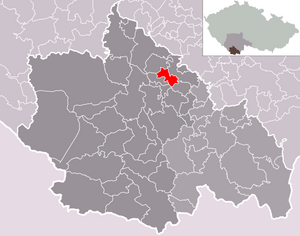Zlatá Koruna
| Zlatá Koruna | ||||
|---|---|---|---|---|
|
||||
| Basic data | ||||
| State : |
|
|||
| Region : | Jihočeský kraj | |||
| District : | Český Krumlov | |||
| Area : | 882 ha | |||
| Geographic location : | 48 ° 51 ' N , 14 ° 22' E | |||
| Height: | 473 m nm | |||
| Residents : | 797 (Jan. 1, 2019) | |||
| Postal code : | 381 01 | |||
| License plate : | C. | |||
| traffic | ||||
| Street: | Holubov - Dolní Třebonín | |||
| Railway connection: | České Budějovice – Černý Kříž | |||
| structure | ||||
| Status: | local community | |||
| Districts: | 3 | |||
| administration | ||||
| Mayor : | Milan Štindl (as of 2018) | |||
| Address: | Zlatá Koruna 41 381 01 Český Krumlov |
|||
| Municipality number: | 545864 | |||
| Website : | www.zlatakoruna.cz | |||
| Location of Zlatá Koruna in the Český Krumlov district | ||||

|
||||
Zlatá Koruna (German Goldenkron ) is a municipality in Okres Český Krumlov in the Czech Republic .
geography
The place is at an altitude of 473 m above sea level. M., six kilometers northeast of Český Krumlov ( Krumau ) on the edge of the Blansk Forest foothills on the left side of the Vltava in the river bend and is, except in the west, surrounded on three sides by the river. Neighboring towns are Nová Koruna in the west, where the train station is located, and Rájov on the other side of the Vltava in the south.
Community structure
The community Zlatá Koruna consists of the districts Plešovice ( Pleschowitz ), Rájov ( Rojau ) and Zlatá Koruna, which also form cadastral districts. Zlatá Koruna also includes the Na Drahách, Harazim ( Harasdin ), Konopáč, Nová Koruna, Podlesí, Sklář, V Zátiší, Ve Strouze and Zelená Strouha residential areas. Basic settlement units are Plešovice, Rájov, Zlatá Koruna and Zlatá Koruna-Horní Část.
Neighboring communities
| Holubov | ||
| Srnín |

|
Dolní Třebonín |
| Přísečná | Mojne |
history
The place arose as a Meierhof west of the monastery Sancta Corona (German Heiligenkron , later Goldenkron ) founded by Přemysl Ottokar II in 1263 . The king had the land made arable by the Cistercians from the Heiligenkreuz monastery and thus operated his own settlement policy in order to oppose a further expansion of the Witigones' sphere of influence . After the Kumans destroyed the monastery, which was still under construction , Wenceslaus II had it rebuilt. Construction was completed in 1291. In the 14th century, Bavor III donated . von Strakonitz gave part of his lands to the monastery. The Cistercians pushed ahead with the colonization of the area: "The area around Goldenkron was then populated by both Czechs and Germans". After a fire in 1354, the Heiliger Chron complex was rebuilt.
In 1420 the Hussites invaded, looted and pillaged the monastery. Ulrich II von Rosenberg took advantage of this to appropriate most of the monastery property. In 1493, Vladislav II handed over the church patronage over Goldenkron to the Rosenbergers on the basis of forged documents from the Rosenberg chancellery . The monastery tried in vain to regain its property; After the Rosenbergs died out, neither the Eggenbergs nor their successors, the Schwarzenbergs, were willing to do this . In the course of the Josephine reforms in 1785, the monastery and the abbey were abolished, and their property fell to the religious fund. At the same time, the Meiereihof and its settlement were outsourced and designated as a village. With the abolition of the manors in Bohemia in 1848 the municipality Goldenkron was established, which belonged to the judicial district of Krumlov in the Krumlov district .
The monastery facilities were then bought by the Schwarzenbergs and leased for various production purposes such as military bleaching and silk spinning. A pencil factory, cardboard factory, cloth weaving mill, machine factory and foundry were also operated in the monastery buildings. The fact that the last resident company went bankrupt in 1909 proved to be advantageous for the preservation of the building. In 1915, the first renovation work began on the run-down buildings.
After the establishment of Czechoslovakia in 1918, Goldenkron belonged to the Český Krumlov district. After the Munich Agreement it remained with Czechoslovakia because of its mostly Czech population and between 1939 and 1945 belonged to the Budweis political district in the Protectorate of Bohemia and Moravia . In 1940 the Gestapo confiscated the Goldenkron Monastery. After the Second World War, Goldenkron / Zlatá Koruna came back to re-established Czechoslovakia; 1946 took place the expulsion of the German population.
After the renovation of the monastery buildings, the České Budějovice State Scientific Library moved into the monastery in 1979, which was declared a national cultural monument in 1995 .
Attractions
Web links
- Website of the municipality on zlatakoruna.cz.
- Zlatá Koruna monastery . In: Online encyclopedia encyklopedie.ckrumlov.cz about Krummau .
Individual evidence
- ↑ http://www.uir.cz/obec/545864/Zlata-Koruna
- ↑ Český statistický úřad - The population of the Czech municipalities as of January 1, 2019 (PDF; 0.8 MiB)
- ↑ http://www.uir.cz/casti-obce-obec/545864/Obec-Zlata-Koruna
- ↑ http://www.uir.cz/katastralni-uzemi-obec/545864/Obec-Zlata-Koruna
- ↑ http://www.uir.cz/zsj-obec/545864/Obec-Zlata-Koruna
- ↑ Ernst Eichler: Selecta Bohemico-Germanica: Czech-German relations in the field of language and culture . LIT Verlag Münster, 2003, ISBN 978-3-8258-6635-8 ( google.at [accessed on January 2, 2018]).
- ↑ http://territorial.de/bm/budweis/gem1940.htm


